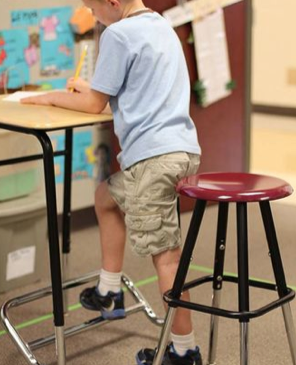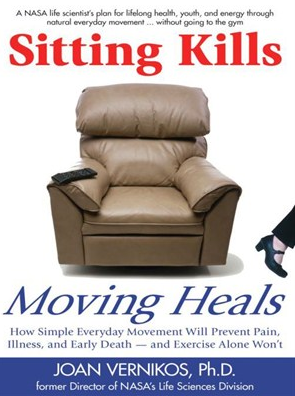 Bernadine Somers and Morgan Academy will be the first school of our region in West Virginia, maybe even the entire East Coast, to experiment with stand-up desks for kids.
Bernadine Somers and Morgan Academy will be the first school of our region in West Virginia, maybe even the entire East Coast, to experiment with stand-up desks for kids.
Most adults and children spend their days engaged in a damaging and unhealthful activity: sitting. Parking ourselves in chairs for long periods results in a chronic shortening of the hip flexors, the muscles that connect the pelvis and lower spine to our legs. At the same time, sitting over-stretches and weakens the gluteus maximus, the butt muscles that power much of our movement. When we stand up and walk erect after hours of being chair-bound, our pelvis and spine don’t immediately return to their balanced, “neutral” position. Our posture remains stooped, and shortened hip flexor muscles impair our strides.
Bernadine understands this in her own body : “As a teacher and administrator, I rarely sit. When I am forced to sit at meetings or conferences, I become fatigued. It is a common belief that in order to concentrate a person must sit. I find this to be the opposite for me and my students. I have always given students the option of standing while they work, and at various times, I will have the entire class stand while working. When a student switches from sitting to standing, concentration levels increase immediately. The decision to use standing desks will beneficial for the students studies and health.”
 A plague of movement dysfunction is now affecting kids. I witness it daily in medical practice and in observing movement in our running store and fitness trails. The elevated shoes play a part here too. Every 1% elevation of a heel causes a 1% change in a joint upstream. In developing parts of the world where children are raised barefoot or in minimal sandals, spend less time in chairs , and walk to school; they move , climb, run, jump with effortless spring.
A plague of movement dysfunction is now affecting kids. I witness it daily in medical practice and in observing movement in our running store and fitness trails. The elevated shoes play a part here too. Every 1% elevation of a heel causes a 1% change in a joint upstream. In developing parts of the world where children are raised barefoot or in minimal sandals, spend less time in chairs , and walk to school; they move , climb, run, jump with effortless spring.
Our seated posture soon becomes our movement posture and it becomes permanent. We have epidemics of ACL tears in young athletes and herniated discs in adults. We were not designed to fail so frequently. Reduced efficiency of movement accompanied by a mild sense of discomfort that reinforces the habit of sitting. This generates a sedentary feedback loop, as the discomfort increases.
Everyday Goal: Keep moving, don’t sit!
Children spend hours in school chairs. Movement guru Dr. Kelly Starrett understands the problem and convinced his children’s school to use stand up desks. Guess what? They love them! Kelly also noticed children’s running and movement patterns were already dysfunctional by the second grade. These are the same patterns we see passed forward to adulthood. As Kelly states “Practice does not make perfect, it makes it permanent”.
In addition to creating these obvious “structural” changes to our bodies, the mere process of sitting sends metabolic signals to store energy. The bigger picture is even scarier. A recent meta-analysis (pooled data) showed even our 30 minutes a day of exercise does not mitigate the sitting. Data pooled from 41 primary research studies, researchers found that long periods of sitting time were positively correlated with all-cause mortality (death), cancer, diabetes, and cardiovascular disease.
 So what is driving this? I think the best mind in the field is scientist Dr. Joan Vernikos, former director of NASA’s Life Sciences Division and author of “Sitting Kills, Moving Heals, and The G-Connection: Harness Gravity and Reverse Aging.” As an Air Force flight doctor, we studied the positive and negative effects of G’s. Mostly through Dr. Vernikos work and the study of pilots and astronauts we learned that prolonged zero gravity greatly accelerated aging and reduced bone mass. We also learned of the acute and chronic effects of high G, mostly with turns in performance air craft. One of the most challenging and body damaging days of my life was going through the pilot protocol of repeat spins to 6 and 9 Gs. I survived the protocol but never in my life had I been body been so sore. It made a marathon seem like a walk.
So what is driving this? I think the best mind in the field is scientist Dr. Joan Vernikos, former director of NASA’s Life Sciences Division and author of “Sitting Kills, Moving Heals, and The G-Connection: Harness Gravity and Reverse Aging.” As an Air Force flight doctor, we studied the positive and negative effects of G’s. Mostly through Dr. Vernikos work and the study of pilots and astronauts we learned that prolonged zero gravity greatly accelerated aging and reduced bone mass. We also learned of the acute and chronic effects of high G, mostly with turns in performance air craft. One of the most challenging and body damaging days of my life was going through the pilot protocol of repeat spins to 6 and 9 Gs. I survived the protocol but never in my life had I been body been so sore. It made a marathon seem like a walk.
“Zero- G sedentary physiology”
The modern zero G is “bed rest” which outside of unique situations should be banned from health care. Prolonged sitting is a close second. “What became abundantly clear to me very quickly was that gravity plays a big role in our physiological function and in the aging process,” Dr. Vernikos says. “We were designed to squat. We were designed to kneel. Sitting is okay, but uninterrupted sitting is bad for us. We are not designed to sit continuously. We are not designed to be in quasi-microgravity. It’s not how many hours of sitting that’s bad for you; it’s how often you interrupt that sitting that is good for you!”
We were not designed to sit all day, nor stand all day. Mix it up and get up at least every 20 minutes if you have a cubicle job. Sit for a break if on your feet like a retailer. Fascinating is the metabolic effects may have to do with hormone lipoprotein lipase which is dramatically reduced during inactivity, and increases with activity. Lipoprotein lipase is an enzyme that attaches to fat in your bloodstream and transports it into your muscles to be used as fuel. This is the gatekeeper to fat utilization. So simply by standing up you are actively helping your body to burn fat for fuel.
Make gravity your friend
The good news is gravity is fun. Dr. Vernikos shares: “I’ve come to the conclusion that all the fun activities that we indulge in are based on gravity,” she says. “All these fun activities, all these games and play that we think of, are gravity-dependent. We are using gravity every which way. The moral to the story is be a child again. Have fun. Play!”
So without even trying — while leaning back in our chairs for hours — we have inadverteantly developed a new medical condition called “zero- G sedentary physiology.” The good news is this can all be changed . The effects of sitting are reversible, mainly through movement and exercise. However, don’t assume that the daily, 20-minute run will undo the other 8 to 10 hours of sitting .
So let’s start with the kids. Get them standing and moving more. It will help their bodies and their brains. Hats off to Morgan Academy for taking bold steps in this direction. There will be student journals about the standing desks, and teachers will record how the children react to the desks in areas of attention spans, energy levels, leg fatigue.
Trust me, the kids will thrive. If you are worried standing up might inhibit learning you are may be wrong. Moving and standing calms kids and opens channels to learning. For more on this emerging movement go to www.standupkids.org


Here is another article and study on the importance of not sitting too much and getting bouts of activity. Mark
http://www.medpagetoday.com/PrimaryCare/ExerciseFitness/53327
“Every 1% elevation of a heel causes a 1% change in a joint upstream.” Is any heel elevation “good” for runners? Or rather, how much is too much? Many of the elites wear shoes with heel elevation and do just fine?
For walking shoes with heel elevation seems self destructive. I don’t know why you would want it while walking other than to “look cool.” Does heel elevation in running shoes serve any physiological function?
Thanks for sharing this, Dr. Mark!! I have a health education presentation on this topic. There is also a study which showed that women who did a moderate amount of physical activity each week (at least the government’s recommended amount) still had an increased risk of cardiovascular disease if they spent more time sitting. (Chomistek et al. (2013). The relationship between sedentary behavior and physical activity to incident cardiovascular disease.)
Sorry to disappoint…Roxbury, NJ has been using these higher tables for three years. We love them.